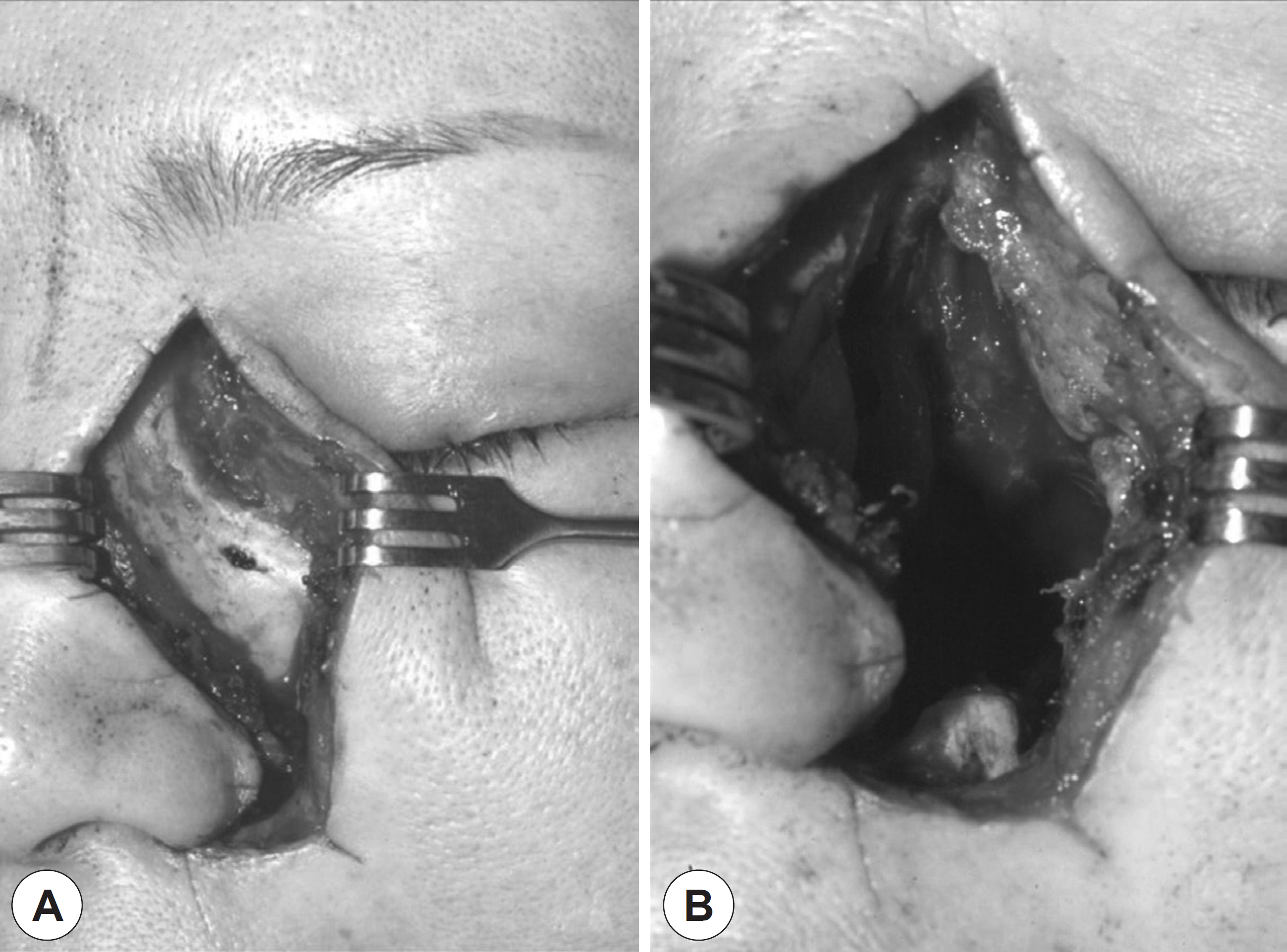J Rhinol.
2017 May;24(1):14-19. 10.18787/jr.2017.24.1.14.
Clinical Characteristics of Lacrimal Sac Tumors: Report of Ten Cases
- Affiliations
-
- 1Department of Otorhinolaryngology-Head and Neck Surgery, Korea University College of Medicine, Seoul, South Korea. lhman@korea.ac.kr
- 2Division of Brain Korea 21 Program for Biomedical Science, Korea University College of Medicine, Seoul, South Korea.
- 3In vitro Diagnostic Medical Devices Support Center, Korea University Guro Hospital, Seoul, Korea.
- KMID: 2379784
- DOI: http://doi.org/10.18787/jr.2017.24.1.14
Abstract
- BACKGROUND AND OBJECTIVES
To review our experience with lacrimal sac tumors in an effort to identify features, to evaluate the results of various methods of management, and to compare our data with previous studies.
METHODS
We reviewed the medical records of all patients with lacrimal sac tumors who were managed in our institution between January 1990 and December 2015. The pre-operative clinical data, imaging, operation notes, and follow-up records were reviewed for each patient.
RESULTS
The study group consisted of four men and six women with a mean age of 47.6 years. Most patients experienced long-standing epiphora, for a mean period of 20 months. Two of the tumors were benign, and eight of them were malignant. The benign tumors were treated with dacryocystectomy. All but one malignant tumor were treated with medial or total maxillectomy. Adjuvant radiotherapy was administered to four patients with malignant tumors. In the eight patients with malignant tumors, the mean follow-up period was 65 months.
CONCLUSIONS
Important characteristics of lacrimal sac tumors include dacryocystitis, epiphora, and in some cases, a palpable medial canthal area mass. Wide en bloc resection via medial or total maxillectomy and/or postoperative radiotherapy are proper treatments for malignant lesions of the lacrimal sac.
MeSH Terms
Figure
Cited by 1 articles
-
A Case of Primary Tuberculosis of the Lacrimal Sac Presenting as Epiphora
Sang Yun Lee, Sangwook Park, Jong-Sil Lee, Yung Jin Jeon
Korean J Otorhinolaryngol-Head Neck Surg. 2021;64(3):202-206. doi: 10.3342/kjorl-hns.2020.00213.
Reference
-
1). Schenck NL, Ogura JH, Pratt LL. Cancer of the lacrimal sac. Pre-sentation of five cases and review of the literature. Ann Otol Rhinol Laryngol. 1973; 82:153–61.2). Hornblass A, Jakobiec FA, Bosniak S, Flanagan J. The diagnosis and management of epithelial tumors of the lacrimal sac. Ophthalmolo-gy. 1980; 87:476–90.
Article3). Ni C, D'Amico DJ, Fan CQ, Kuo PK. Tumors of the lacrimal sac: a clinicopathological analysis of 82 cases. Int Ophthalmol Clin. 1982; 22:121–40.
Article4). Spira R, Mondshine R. Demonstration of nasolacrimal duct carcinoma by computed tomography. Ophthal Plast Reconstr Surg. 1986; 2:159–61.
Article5). Stefanyszyn MA, Hidayat AA, Pe'er JJ, Flanagan JC. Lacrimal sac tumors. Ophthal Plast Reconstr Surg. 1994; 10:169–84.
Article6). Saccogna PW, Strauss M, Bardenstein DS. Lymphoma of the nasolacrimal drainage system. Otolaryngol Head Neck Surg. 1994; 111:647–51.
Article7). Pe'er J. Lacrimal Sac Tumors. Clinical Ophthalmic Oncology. Springer;2014. p. 115–21.8). Parmar DN, Rose GE. Management of lacrimal sac tumours. Eye (Lond). 2003; 17:599–606.
Article9). Montalban A, Liétin B, Louvrier C, Russier M, Kemeny J-L, Mom T, et al. Malignant lacrimal sac tumors. European annals of otorhino-laryngology, head and neck diseases. 2010; 127:165–72.
Article10). Ryan SJ, Font RL. Primary epithelial neoplasms of the lacrimal sac. Am J Ophthalmol. 1973; 76:73–88.
Article11). Skinner HD, Garden AS, Rosenthal DI, Ang KK, Morrison WH, Esmaeli B, et al. Outcomes of malignant tumors of the lacrimal ap-paratus: the University of Texas MD Anderson Cancer Center experience. Cancer. 2011; 117:2801–10.12). Rootman J, White VA. Changes in the 7th edition of the AJCC TNM classification and recommendations for pathologic analysis of lacrimal gland tumors. Arch Pathol Lab Med. 2009; 133:1268–71.
Article




